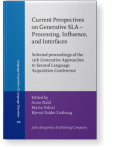Chapter 14
The narrative skills of Russian-Cypriot Greek children
Macro- and micro-structure, disfluencies and grammaticality analysis
This study investigates the narrative skills of Russian-Cypriot Greek bilingual children, with a focus on macro-
and micro-structure, grammaticality, and disfluencies. The results show a correlation between the rates of macro- and micro-structure
measures, grammaticality, and disfluencies in the heritage language, Russian. Mode of narration, age, and language proficiency affect
the narrative production. The most prominent disfluency types are repetitions, filled pauses, and lexical and grammatical revisions,
which can be due to the activation of both languages and cross-linguistic interference. The grammaticality analysis revealed that the
most vulnerable domain for bilingual children was in the functional categories. This research provides further evidence to Russian
heritage language research for early-stage language development, with a new societal majority language, Cypriot Greek.
Article outline
- 1.Introduction
- 2.Bilingual language development and narrative skills: Macro- and micro-structure
- 2.1The aims of this study
- 3.Study
- 3.1Participants
- 3.2Materials and procedure
- 3.3Data analysis
- 4.Results
- 4.1HL proficiency measures
- 4.2Macro-structure measures
- 4.3Grammaticality
- 4.4Micro-structure and disfluencies analysis
- 5.Discussion and conclusion
-
References
-
Appendix
This content is being prepared for publication; it may be subject to changes.
